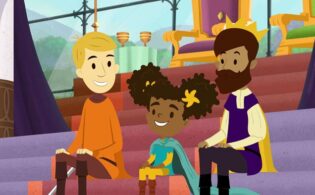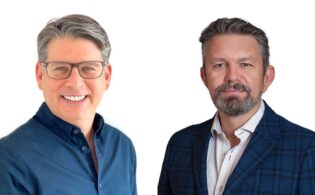CAKE’s Ed Galton, Guru Studio’s Frank Falcone, DeAPlaneta Entertainment’s Carlos Biern and Big Bad Boo Studios’ Shabnam Rezaei offered their insights on how to cobble together the financing on shows in a TV Kids Festival panel today.
The session, moderated by TV Kids’ Anna Carugati, can be viewed here. It featured Galton, CEO of CAKE; Falcone, the president and executive creative director of Guru; Biern, director of content and distribution for kids and family at DeAPlaneta; and Rezaei, the co-founder of Big Bad Boo.
On how risk-averse broadcasters and platforms are today, Galton noted: “We’re seeing the after-effects of what’s happened with Covid. Officially we’re not in a recession, but I would say the entertainment industry probably already is in a recession. Buyers are being more cautious about the content that they are trying to acquire. Budgets have been put on hold. I anticipate 2023 to be somewhat of a different difficult year. But I think once we get past 2023, in 2024 or 2025 things will start getting better again.”
Falcone agreed, observing: “There was an abundance of content created with overexuberance and enthusiasm for the people trapped at home that were suddenly a captive audience. A lot of that content isn’t attracting the eyeballs. It’s a time to regroup and look closer at what we’re commissioning. It’s healthy for the business to make things that people watch and not burn money on shows that never find an audience.”
Biern concurred, adding, “It’s the final result of less consumption, less income coming from other sources of business, like licensing, consumer products. Obviously, on theatrical, the box office has also been directly impacted. Everybody is looking into expanding the business, the audiences and the ratings. [Buyers are] cautious, but they need us with respect to the content.”
“At a very high level, the industry has over-created content,” Rezaei said. “You see that with Netflix and even Amazon Prime. There’s also a problem with the audience finding the content. At Big Bad Boo, we produce a lot of educational shows, which tend to get financed through public channels, from governments, and that’s a whole other world of financing that’s slightly different from the commercial side. We’ve seen the budgets of public broadcasters get cut over the years. Unfortunately, that is a downward trend because of the platforms’ dominance and the regional stations trying to keep up with the big platforms. There are so many things going on at once that it’s hard for me as a producer to know what those big levers are. We just put our heads down and create content that we believe in. I almost want to say I don’t care what’s happening in the market trends. I want to make the content I want to make, and I will find the financers to make those shows.”
Falcone noted that commissioners are looking for properties with some built-in awareness. “That long path of discoverability is a difficult thing to invest in. But the irony is, that’s where the good stuff will come from.”
“What I find disheartening is when you’re pitching, and the broadcaster or the person with the money says, is this brand already established? And if it is in some other form, a book, a blog, or a game, how many followers do they have? It’s almost like they want to piggyback off the success of something that already exists, as opposed to saying, Hey, I’m Netflix, I’m going to put money behind this brand and make it the next great show. As producers, we go to the platforms for the eyeballs, but we have to bring the eyeballs now as well.”
“Platforms are starting to realize that it’s very hard to launch new IP,” added Galton. “The discoverability factor is very important, becoming a major issue for these platforms. These platforms weren’t designed with kids in mind. The viewing patterns of the way kids are, and the way the platforms work—they haven’t figured out how to work together yet. Until we get to that point, it will be difficult for us to launch new IP. They are reliant on known brands because the marketing is already built in.”
“It’s really hard for a service like Netflix to know what to feed you when kids are jumping accounts,” Falcone added. “The business model for understanding what you want to watch is bumpy right now. When you’re watching the algorithm to get an indication of what you should be feeding kids, it’s just not giving us what we need. As creators, we have to come up with stuff that fills the white space because I think the data is corrupt.”
Commercial broadcasters, meanwhile, seem more interested in the “business case” for a show, Falcone added. “Because their audience is dwindling, they’re looking for other ways to create revenue. It makes sense, but it also puts the burden on producers to have a business plan around their shows.”
Galton agrees. “Advertising revenues are going down. They have to figure out a way to justify their business. That means they need to find additional revenue streams to continue doing what they do. Known brands, and safe bets, that’s what people are looking for at the moment. At some point, you’re going to run out of safe bets.”
On how these trends at streamers and channels have changed funding mechanisms, Falcone noted: “We see consistently 20 to 30 percent gaps in our financing across all shows. You have an anchor tenant and other broadcasters, and then you’ve got this large nut to crack. The discussion can only move toward venture capital and private equity financing. That seems to be the only place to go, which creates a lot of challenges for producers because the business for that show has to be greater than just the sale of content to other broadcasters. It has to be a much larger package of a larger offering. I feel for anyone entering the business right now as a TV producer who wants to just make a show. If your company’s positioned with the ability to flex in licensing and other areas, you can at least bring that to the table. For an independent producer, it becomes a lot more challenging to raise the financing. You’re dependent in some ways on the graces of a public broadcaster or the belief that the show will matter from an executive someone. And that’s dwindling, given the lack of success some of these big swings have created on the platforms in the last couple of years.”
The influx of money into the ecosystem over the last few years also set unreasonable long-term expectations, Galton noted. “When you have people like Netflix giving you 100 percent finance to make a show; they’re giving you $15 million to $18 million to produce a series, and then suddenly that starts to go away, that’s becoming a problem for a lot of people. We’re relying on a small number of platforms that were doling out a lot of money to get shows off the ground. We’re almost going back to the model that some of us were very successful at for many years, which is putting multiple partners together to get to 100 percent. That is the model that we’re looking at. We would love to continue working with people like Netflix, Disney and all the other platforms that can get you to 100 percent faster. But there will also be those co-pro models that we will cobble together deals to get us to 100 percent so we can go into production.”
Falcone agreed and believes this is a positive development. “You have to be willing to share in having people participate in the success of a show, especially if they’re contributing financially and putting some risk money forward. If people are honest about their deal-making and willing to create those fair models, we can work together better. That’s the change from maybe ten years ago when some big players were creating co-productions with smaller players that maybe weren’t as advantageous to the upstarts. The new production model is about getting everything set up with a lot of transparency.”
Biern added: “Sometimes building up shows on brands is a huge amount of money, and maybe we don’t have those resources as quickly as we did three, five years ago. But technology will help us. As creators, we have to spend much more time on building up brand awareness that could be global and also using production technologies that will allow us to work with shows and interactive experiences. We can overcome these difficulties by building up global brands that can stand for three or five years without having to work out a 52×11-minute or 104×7-minute show. Technology and storytelling are the keys to bringing those brands up.”
On demands for exclusivity, Galton noted: “I’ve been a big advocate of sharing of rights and non-exclusive rights for as long as I’ve been doing this job. Brands can’t exist on one platform anymore. You don’t have enough eyeballs anymore to allow brands to succeed. You have to be on multiple platforms to get maximum eyeballs. The platforms and the broadcasters are all now starting to understand that. It’s not perfect yet, and there’s still a long way to go, but we’re seeing a lot more cooperation than we have in the past. I hope this will continue to do so without degradation of investment and license fees from our partners.”
The panelists agreed that the FAST channel space presents a raft of opportunities—and an equal number of challenges. “It is a bit sloppy at the moment,” Galton said. “I liken it to the syndication business back in the day—you’re running around trying to populate all of these different platforms with your channel. Or you’re working with a partner that has already done that legwork and giving them a significant cut of the rev share to do that. It is sort of like YouTube 2.0. The barriers to entry are small. You just need content and then the investment to get a channel going. Ultimately, you don’t have the marketability and the discoverability of getting people to watch your channel. That’s going to be the biggest challenge. If there are 5,000 channels, how successful is this business going to be? I am a huge believer that our future is in the ad-supported video-on-demand business, one way or another. It’s just a matter of how that shakes out and how the platforms come together and allow that to happen. I believe that that will be where we will ultimately profit in the future.”
Biern agreed, noting, “The good thing is that the audience is getting used to it. It’s a model that is going to be sustainable in the next five to ten years.”
The panel wrapped with a conversation about whether the industry is equipped to overcome this year’s challenges.
“We have to be prepared for maybe a little bit of a longer winter than a typical down cycle would be,” Falcone said, “and to be a little more creative and more collaborative in terms of how we get projects going so that we can survive. I think there’s going to be a lot of consolidation. There’s going to be a lot of data crunching. There’s a lot of data out there in a lot of different pools, and someone’s going have to put it all together and say, What does this all mean? We’re still not in a phase where we know how to measure success, so it’s harder for any investor to put money against something if they don’t know what their goals are for success.”
Galton added: “We don’t have massive studios. We don’t have massive overheads. We don’t have 15 shows in production at one time. I worry about those studios that do. Having maximum flexibility is good. Having belief in your content. Good quality will always find its way to the top and find its way to get made. In the next 12 to 24 months, you might have a clear out of projects and producers that maybe should not have been making the content that they’re making. Sometimes businesses don’t work, and some have to fail for the industry to continue. We might encounter that in the next 12 to 24 months. That is the nature of industry. And we just have to be convinced that the type of shows we put forward will ultimately succeed.”
Rezaei noted: “Our sales, development and production cycles are long. So if something’s happening in the economy where there’s a downturn, I like to just look the other way, put my head down and make sure that we are okay financing and making this show. We’ve lived through some cycles, and markets will continue to consolidate. Expenses are going up. We have to pay our people more. Energy costs are higher, so production budgets have to be bigger. Broadcasters and platforms need to realize that. They need to realize that we can’t make this show with the same money that we made it with two years ago because of all the living expenses that are going up for everyone around the world. There are so many things at play here. If you go down that rabbit hole of thinking about, all these things are happening, you could go down a dark path, and we don’t do that. We stay positive. We stay true to the content we want to make, and we believe there’s a great audience for it.”
“I’m very positive as well,” Biern said. “Concerning consumer products, I think we have suffered a lot in the last three years. All the manufacturing people that work with our characters. Even consumption is more difficult, and there is less income for many families worldwide. Licensing consumer products will be back again in the next two or three years. That’s going to have a positive impact. Kids and family content is needed. Global shows will always happen.”
 TVKIDS
TVKIDS






